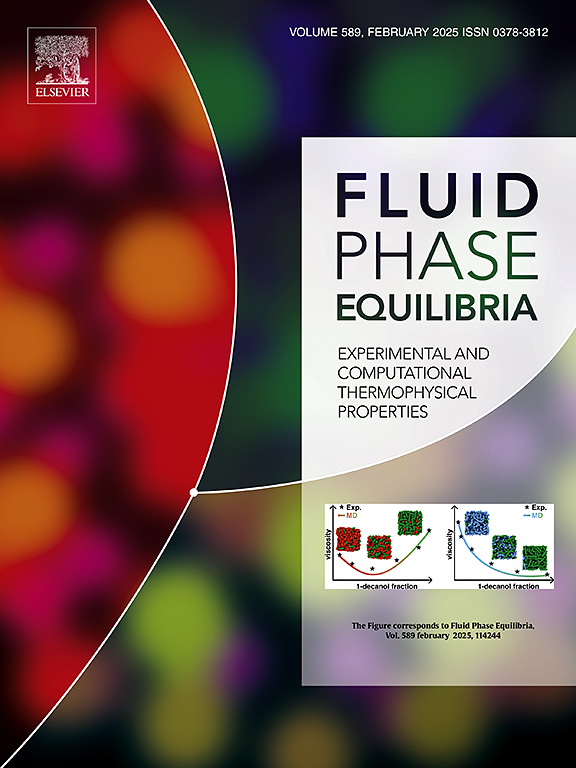Investigation of the molecular architecture influence on the solid-liquid transition of ethylene/1-octene copolymers in butylal
IF 2.7
3区 工程技术
Q3 CHEMISTRY, PHYSICAL
引用次数: 0
Abstract
The molecular architecture, in terms of molecular weight and branching, linked with the semi-crystallinity of the polymer, plays a key role in solid-liquid equilibria in polyethylene-solvent systems. Lattice Cluster Theory, in combination with continuous thermodynamics, captures these molecular features and has been successfully applied in the past to predict solid-liquid equilibria of polymer solvent systems. While the solubility of linear low-density polyethylenes in chlorinated solvents has been studied in depth in the past, few investigations have addressed their solubility in less toxic and environmentally more friendly solvents, particularly in relation to the influence of molecular architecture. This study aims to fill this gap by investigating the relationship between molecular architecture of ethylene/1-octene copolymers, covering a wide range of branching levels from 3.5 to 54.6 CH/1000 C, and their solid-liquid phase transitions in butylal. By combining cross-fractionation chromatography, preparative crystallisation fractionation and Lattice Cluster Theory, the solid-liquid transitions of these material systems are elucidated and an architecture-solubility relationship is established. This approach provides detailed insights into how molecular architecture influences crystallisation behaviour, provides a basis for the design of ethylene/1-octene copolymer fractions with tailored microstructural features, and demonstrates the predictive power of Lattice Cluster Theory.

丁醛中乙烯/1-辛烯共聚物固液转变的分子结构影响研究
分子结构,就分子量和分支而言,与聚合物的半结晶度有关,在聚乙烯-溶剂体系的固液平衡中起着关键作用。晶格簇理论与连续热力学相结合,捕捉到了这些分子特征,并在过去成功地应用于预测聚合物溶剂体系的固液平衡。虽然过去对线性低密度聚乙烯在氯化溶剂中的溶解度进行了深入研究,但很少有研究涉及其在毒性较小和对环境更友好的溶剂中的溶解度,特别是与分子结构的影响有关。本研究旨在通过研究乙烯/1-辛烯共聚物的分子结构之间的关系来填补这一空白,乙烯/1-辛烯共聚物涵盖了3.5至54.6 CH/1000 C的广泛分支水平,以及它们在丁醛中的固液相变。通过结合交叉分馏色谱、制备结晶分馏和晶格簇理论,阐明了这些材料体系的固-液转变,并建立了体系结构-溶解度关系。这种方法提供了分子结构如何影响结晶行为的详细见解,为设计具有定制微观结构特征的乙烯/1-辛烯共聚物馏分提供了基础,并证明了点阵簇理论的预测能力。
本文章由计算机程序翻译,如有差异,请以英文原文为准。
求助全文
约1分钟内获得全文
求助全文
来源期刊

Fluid Phase Equilibria
工程技术-工程:化工
CiteScore
5.30
自引率
15.40%
发文量
223
审稿时长
53 days
期刊介绍:
Fluid Phase Equilibria publishes high-quality papers dealing with experimental, theoretical, and applied research related to equilibrium and transport properties of fluids, solids, and interfaces. Subjects of interest include physical/phase and chemical equilibria; equilibrium and nonequilibrium thermophysical properties; fundamental thermodynamic relations; and stability. The systems central to the journal include pure substances and mixtures of organic and inorganic materials, including polymers, biochemicals, and surfactants with sufficient characterization of composition and purity for the results to be reproduced. Alloys are of interest only when thermodynamic studies are included, purely material studies will not be considered. In all cases, authors are expected to provide physical or chemical interpretations of the results.
Experimental research can include measurements under all conditions of temperature, pressure, and composition, including critical and supercritical. Measurements are to be associated with systems and conditions of fundamental or applied interest, and may not be only a collection of routine data, such as physical property or solubility measurements at limited pressures and temperatures close to ambient, or surfactant studies focussed strictly on micellisation or micelle structure. Papers reporting common data must be accompanied by new physical insights and/or contemporary or new theory or techniques.
 求助内容:
求助内容: 应助结果提醒方式:
应助结果提醒方式:


